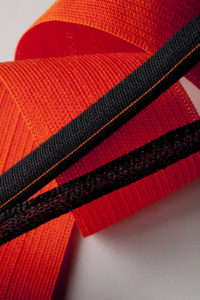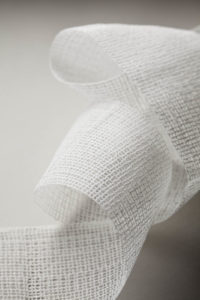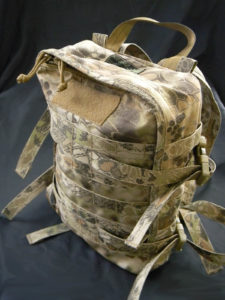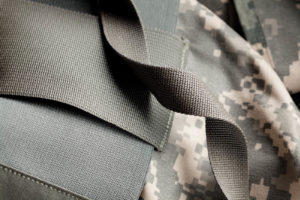
Narrow fabrics are matching the high-performance needs of safety, medical and military markets with their own technological advances.
Say “narrow fabric” and the average consumer may think of ribbon and zippers. The markets for narrow fabric manufacturers go far beyond those products, and with ongoing technological advances are broadening even further.
Carolina Narrow Fabric proves the point. Founded in 1929, the company based in Winston-Salem, N.C., didn’t start with an interest in the aerospace market, but that’s where it now is expending energy—and that means its products are soaring.
“With [their planes’] life spans coming up, Boeing and Airbus are as busy as ever,” says Jeffrey Freeman, Carolina Narrow Fabric’s president and CEO. “Capacity in the market cannot supply the aerospace industry with the needs they will have over the next five years.”
His company so believes in this market that it is applying to become an aerospace certified supplier. “We also are seeking 13485 ISO certification for orthopedic materials,” Freeman adds. “We are seeing growth in that market internationally.”
Offray Specialty Narrow Fabrics’ history dates back to 1876. In its third-century presence, the Bernardsville, N.J.-based company serves a range of market segments. “The most dynamic markets that we serve are industrial, aerospace and medical, followed by fire/safety and military,” says Timothy Offray, business development manager.

“Remote monitoring, management of the body condition and use of high-performance fibers to enhance safety are key in these market segments. Our materials are engineered to service high-performance textile applications. Many of our products are composed of high-performance fibers, such as Kevlar®, Nomex®, PBI®, Dyneema®, Spectra®, Vectran® and more. E-textiles and smart fabrics are the two leading solutions that are directly related to the growth of advanced technology,” Offray says.
Murdock Webbing Co. Inc. of Central Falls, R.I., is working with several of those high-performance fibers, as well as with NanoSphere® from Schoeller Technologies of Switzerland. Murdock Webbing was founded in 1936 to weave venetian blind tape, but during World War II expanded into the military market, which it still serves with some of its more technologically advanced products.
“We do a wide array of camouflage patterns in a unique manner,” says Greg Pilgrim, chief operating officer. While most companies print camouflage patterns onto fabric, Murdock Webbing has developed a woven jacquard that meets infrared ratings and features night vision breakup.
“If you look through night-vision goggles, there’s a distortion to the webbing so it doesn’t look like a clean line,” Pilgrim explains. “In older days, solid-color webbing would look like a stripe across a bulletproof vest or backpack. With the camouflage pattern coming to fruition, it blends with the material. It has high, low and medium colors that reflect differently.”

Material advances
Even with reliable demand, a company needs to continue tweaking its product line in today’s fluid, globally connected world. For example, BioThane Coated Webbing of North Ridgeville, Ohio, recently developed a lacing product for the sporting goods market—a product designed to replace leather and nylon, which tend to fray and get dirty. But shoelaces aren’t BioThane’s sole step into narrow fabrics with advanced technology.
“We developed our G2 coating technology that is being used in the medical and safety markets,” says Ethan Boron, president. “It is extremely thin, so it feels soft and flexible, yet it is still cleanable, durable and waterproof, like our G1 coating. We are preparing to launch a line of coated tubular products and fire-retardant products for fire and aerospace uses.”
According to Boron, BioThane was the first company to begin coating narrow webbing (in 1977), and it has developed all of the markets it’s in “from scratch,” he says.
Industrial, automotive, medical, military and fire/safety markets are all seeking the most technologically advanced narrow fabrics from AEC Narrow Fabrics of Asheboro, N.C. The company is developing lighter weight, fire-retardant and abrasion-resistant textiles for military, automotive and aerospace customers.
“We are working hard to develop new, innovative fabrics that address these opportunities in effective ways,” says Gifford Del Grande, director.
“The narrow fabric market is most definitely experiencing change as products and materials are becoming more sophisticated and as engineers incorporate textile performance attributes into product design,” Offray says.
“The narrow fabric industry in the United States is beginning to capitalize on the new and diverse uses of webbings and tapes,” he adds. “Performance-based applications are directed toward medical solutions: lighter weight products that don’t compromise performance or tensile strength, flammability, elongation and toxicity standards.”
In addition to the military market, Murdock Webbing serves industrial clients with technologically advanced webbing for fall protection, including self-retracting lanyards, a newer style of deceleration device. With life and limb at risk, energy absorption is critical; and this is an area, Pilgrim says, in which his company has focused development, especially using Dyneema for a lower profile while maintaining tensile strength.

“New fiber choices tend to open up some small markets,” Pilgrim says, giving search-and-rescue applications as an example. He thinks changes for narrow fabric manufacturers, which he considers a mature industry, will be on the niche level. And while his own company does not serve the medical industry, he sees that as a growing market for those that do.
Carolina Narrow Fabric is focusing on advanced composites for its aerospace, military, marine and recreation clientele. And, Freeman says, “The economy in general has been better, so there are a lot of repairs being made. It could be new construction, concrete repair or corrosion resistance on structures. There’s a lot to be done in the construction market, and advanced composites are showing some real growth there.”
“Then you have some pipeline markets that have come out. People are talking about the Keystone Pipeline. I think that will create jobs for textiles,” he says, referring to the use of narrow fabrics to seal and reinforce natural gas pipelines.
“There are new materials out there for composites, allowing different systems to evolve. They’re comingling fibers, exploring different combinations and what kind of properties they offer,” Freeman says.
“New materials often have properties that permit combining current fabric technology with new fibers, resins or fabric treatments,” adds James Snipes, Carolina Narrow Fabric’s vice president of product development and engineering.
“We see growth and technological advances in composites. As the country becomes more energy independent, the clear advantages of weight-to-strength of composites will result in greater usage in automotive and aerospace. Infrastructure improvements, including pipeline repair and structural improvements ranging from bridges to buildings, will become routine,” Snipes says.
Del Grande agrees that composite textiles are key for developing narrow fabric markets. “They can provide enhanced thermal, mechanical and/or electrical features within the context of woven or knitted narrow fabrics used in many industries,” he says.
The promising future
“Improvements [in the narrow fabric products market] likely will evolve as users become more advanced,” Snipes says. “Usually the demand for change starts with the original equipment manufacturers, and we develop fabrics that can meet the requested changes. The usage and modification of carbon fabrics with thermoplastic fibers will continue to replace other materials.”
“Most people do carbon-fiberglass composites. Carolina Narrow Fabric is producing a carbon-carbon material,” Freeman says. More recently, the company has been developing a product that blends fiberglass and the polyfiber Innegra™ for an advanced application that Freeman expects will be announced in early 2016.

“There is opportunity for growth in all narrow fabric markets if narrow fabric manufacturers develop useful technologies that address safety and performance,” Del Grande says. “For example, in the fall-restraint market, construction workers can have a better on-the-job experience wearing a harness that is lighter, safer and more comfortable.”
“Narrow fabrics that protect and simplify the inner workings of machinery, seatbelts that warn drowsy drivers and swimsuit elastic that changes color when more sunscreen is needed may be dreams today and hot products in the not-too-distant future,” Del Grande speculates.
“Innovation is always going on. The key is to get to the right people within each market who are helping drive change,” he says. “I’m a believer in networking and establishing long-lasting relationships. Those relationships can be useful in identifying the influencers and decision makers in various markets.”
Offray thinks the growth in technologically advanced textile markets will be in “anything that monitors the body’s performance and condition,” including garments for sports and personal protection, as well as remote patient-monitoring apparel, work wear with communication systems and space suits.
“We are on the edge of ‘what could be’ as technology is evolving,” Offray says. “Textile structures will become more complex, and the use of high-performance fibers and smart coatings with innovative, added properties will grow exponentially.”
“As markets change, you have people trying to get into new and different applications and trying to find another avenue to pursue. So you will see some new players coming on,” Freeman predicts. “There’s a need for some capacity in those markets on the composite side of things. I think you will see companies growing and diversifying.”
Pilgrim notes the consolidation of several narrow fabric manufacturers as they strive to gain bigger footholds into market share. “I wouldn’t be surprised if there wasn’t more consolidation,” he says. “The [narrow fabrics] industry in the United States continues to consolidate,” Boron agrees. “The remaining players are very capable and competitive. You must find ways to grow and compete on a global scale. New product and market development seem to be a point of emphasis with the remaining companies.
“We think things will continue to push toward smaller, lighter, finer, while increasing or adding attributes,” he says. “It should be a fun ride.”
 TEXTILES.ORG
TEXTILES.ORG


